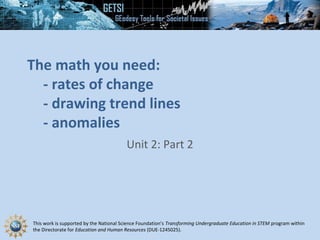
Helpful Math slides - Unit 2 Part 2
- 1. This work is supported by the National Science Foundation’s Transforming Undergraduate Education in STEM program within the Directorate for Education and Human Resources (DUE-1245025). The math you need: - rates of change - drawing trend lines - anomalies Unit 2: Part 2
- 2. What is a rate? Any change with respect to time is called a rate. Examples in the geosciences? • plate tectonic velocities (distance over time) • crystal growth rates (change in crystal size over time) • river and groundwater discharge (volume change over time) • decay rates (change in number of parent isotopes over time)
- 3. Rates of change – Determining rates from a graph 6.0 - 2.5 billion people 2000 - 1950 years 0.7 bill. people/yr== Calculate the rate of population growth from 1950 to 2000.
- 4. Draw a trend line Why and when do I need one? • Most exercises that ask you to construct a best-fit line have to do with wanting to recognize relationships among variables on Earth or to predict the behavior of a system. • Also called: best-fit line, linear regression http://serc.carleton.edu/ma thyouneed/graphing/bestfit. html
- 5. Draw a trend line http://serc.carleton.edu/mathyouneed/graphing/bestfit.html A best-fit line is meant to mimic the trend of the data. In many cases, the line may not pass through very many of the plotted points. Instead, the idea is to get a line that has equal numbers of points on either side. 1.Plotalldata 2.Drawshape aroundalldata 3.Bisectthe areawitha line 4.DONE!
- 6. What are anomalies? Anomalies are the difference between a reference temperature (or some long-term average) and the temperature that is recorded for a particular year. temperature data temperature anomaly data (anomaly with respect to 1980–2000 data) Created using data from: http://data.giss.nasa.gov/gistemp/graphs_v3/
- 7. What are anomalies? Anomalies are the difference between a reference temperature (or some long-term average) and the temperature that is recorded for a particular year. Anomaly from 1960–1980 temperatures http://data.giss.nasa.gov/gistemp/graphs_v3/
Notas do Editor
- <number>